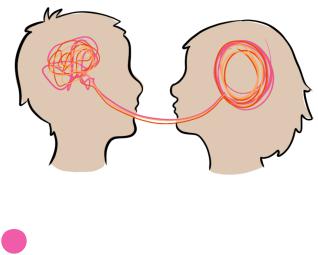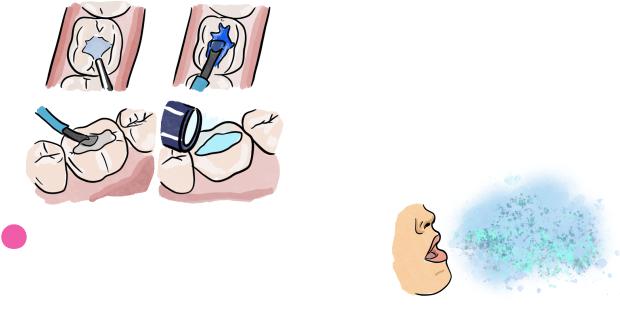
Полезные материалы за все 6 курсов / Учебники, методички, pdf / INBDEBooster Patient Management Notes
.pdf
INBDE PATIENT MANAGEMENT NOTES |
1 |
Patient Management
Patient management is one of the most important subjects tested on the INBDE. Comprising a significant portion of the overall test, the contents of this chapter cover a variety of levels of patient management practiced by a dentist. We’ll help you drill the most high-yield concepts for the INBDE, and provide helpful tips and tricks for answering the patient management questions on the exam.
1 Interpersonal Communication
A unique aspect of being a dentist is the number of hats you’ll wear in a professional setting. Not only will you be serving as the leading healthcare provider, you will be responsible for maintaining an environment that is welcoming for anyone who walks through the doors of your practice — whether they be your patients or staff members. It is widely held that it takes as little as 7 seconds to make a first impression, so exhibiting the highest level of interpersonal skills and qualities is of supreme importance. The skills outlined throughout this section, and following sections should not be compromised under any situation.
•Active Listening - opposed to passive listening, active listening requires conscious effort to hear, understand, and retain information that is being conveyed to you
Dentist qualities: ensure you are paying sustained attention to your patient by waiting to speak, practicing non-verbal listening cues like mirroring.
-Active listening is also a crucial component of building rapport with the patient. By encouraging the patient to share further details and responding in a reassuring manner, you are actively working towards a more trustworthy dentist-patient relationship
•Empathy - going to the dentist is a highly vulnerable experience for many patients. Being a dentist who understands how the patient feels, and also provides emotional support can make a world of a difference in the patient’s receptivity to your advice and treatment
Dentist qualities: a ‘person focused’ dentist is one who both validates how a patient feels, and then fosters a sense of togetherness between themselves and the patient
Dr. Brené Brown emphasizes the importance of empathy in human connection in this video
I feel so unconfident speaking to friends and coworkers because I can always see them judging my crooked teeth and uneven smile
I understand how you feel, and why this has been weighing on you. Let’s work together to plan a course of treatment that will suit you and your needs best.
INBDE Booster | Booster PrepTM

INBDE PATIENT MANAGEMENT NOTES |
2 |
•Nonverbal Communication - also called manual language, this is the transmission and retrieval of messages without using words, either spoken or written
Dentist qualities: Incorporating strong nonverbal communication skills including making good eye-contact with the patient, using facial expressions to demonstrate listening, and using appropriate touch/gestures can enhance a patient’s experience.
Patient qualities: Observe for changes in posture, such as tensing or clenching of hands, uncomfortable movements, or changes in facial expressions during appointments.
•Verbal Communication - the transfer of information using speech, verbal communication is essential to a successful dentist-patient relationship
Dentist qualities: Use the mnemonic “EQuaL CRaiG” to remember the 6 most important areas of verbal communication to practice:
1.Explain terms clearly and concisely without using excessively complicated dental jargon
2.Question your patient to assess their understanding of your advice or treatment plan
3.Listen to any questions or concerns the patient or patient’s family has
4.Clarify and paraphrase patient misunderstandings
5.Repeat your thoughts appropriately
6.Goal setting for future appointments and sharing an estimated treatment timeline will provide important perspective for the patient
Let’s delve into more targeted communication that takes place in the dental setting!
2 Healthcare-Specific Communication
Establishing strong and clear communication when conveying information related to treatment, insurance, or healthcare systems is vital. In doing this, you are minimizing chances for confusion, and are building transparency with all parties involved.
•Clinical Interviewing - asking the right questions in an appropriate manner can assist your overall diagnosis greatly
A mnemonic to keep in mind is the 4 P’s:
1.Probing questions help you uncover background information, and also encourage the patient to think more deeply about their oral health. Do not use leading questions that prompt a patient to respond a certain way
“Are you happy with the quality of your smile?”
“How often do you see the dentist?”
2.Problem discovery questions can be both open and close-ended, however open-ended questions are preferred as these lead to greater conversation and identification of potential issues
“Do your gums bleed when you brush or floss?”
“If you could change one thing about your smile what would it be?”
INBDE Booster | Booster PrepTM

INBDE PATIENT MANAGEMENT NOTES
3.Pain amplification questions reveal information about emotional and physical pain
“How long have you experienced cold sensitivity in this area?”
“Is this tooth sensitive if I blow air on it?”
“Are you concerned that pain will worsen if we don’t do anything right now?”
4.Pleasure discovery questions can help you best understand how to provide the best overall treatment for the patient
“What’s most important to you about the dental treatment you receive?”
“Is there something you really liked about the dentist/dental office you used to go to?”
At the end of the day, it is essential that you are giving the patient ample opportunity to explain what is important to them.
•Treatment Planning - once you have a strong grasp of the patient’s condition, it is time to communicate a treatment plan, including recommended dental services, the timeline, and associated costs before and after insurance, if applicable
3
In-office conversations and demonstrations can have the greatest impact on a patient’s receptivity to your proposed treatment plan. Provide a ranked list of treatments in order of decreasing desirability, and listen to the patient’s concerns
Make use of easy analogies and short stories to drive understanding. Have the patient teach back to you what they understand
•Insurance terms - dental insurance, and health insurance in general, has its own comprehensive vocabulary of terms that are important to know. Here are some high-yield terms to devote to memory:
1.Allowed charge: the highest amount insurers will pay for covered services, and includes any amount the patient will pay
2.
2.Annual maximum: the maximum amount dental plan or policy will pay towards the cost of a patient’s dental services
3.
3.Appeal: a formal request for review of denied or unpaid claims; an attempt to receive 3rd party payment
4.
4.Beneficiary: the person(s) covered on a dental insurance plan
5.
INBDE Booster | Booster PrepTM

INBDE PATIENT MANAGEMENT NOTES
5.Closed network/panel plan: dental plans that require patients to use a network dentist in order to receive benefits (ex: DHMO)
2.
6.Co-insurance: some patients may share the costs of dental services, which are calculated as percentages of the charged amount
3.
7.Co-pay: a pre-set fee a patient must pay for each dentist visit or for a specific treatment
4.
8.Deductible: amount the patient pays before the insurance plan begins to pay
Many patients will have family deductibles, or the max amount a family needs to meet for co-insurance to kick in for everyone in the family
5.
9.Flexible Spending Account (FSA): a special account patients put money into that they can use to pay for certain out- of-pocket healthcare costs
Patients do not pay taxes on this money
6.
10.Health Savings Account (HSA): a taxadvantaged savings account that members can withdraw funds tax-free to use for dental care expenses
7.
11.Open panel plan: permits member to seek covered health care exclusively from out-of-network providers
8.
12.Premium: the amount a patient pays to a dental insurance company for dental coverage, and is usually paid in monthly installments
4
•Dental insurance plans - Below is a summary of plans relevant to the INBDE
1.Dental Exclusive Provider Organization (DEPO): members must use an innetwork dentist, and members can see specialists without referral. Specialist visits are covered as long as dentist is innetwork
2.Dental Health Maintenance Organization (DHMO): dentists in this network are paid a monthly fee for each patient that signs up for the plan and selects that dentist (capitation plan)
Pros: generally cost the patient less money; dentist within HMO network cannot refuse to treat that patient
Cons: patient will need primary dentist to receive referrals to a specialist; patients will need to pay full treatment costs for out-of-network dentists
3.Dental Preferred Provider Organization (DPPO): these insurance plans contract with dentists for a discount from usual fees. Patients typically pay less for treatments when done by dentists in DPPO network, and dentists are paid on fee-for-service basis after service is done (high volume of patients)
Pros: plans are more lenient for allowing patients to choose a dentist
Cons: higher out-of-pocket costs; PPO plan may limit amount of coverage per year
4.Discount Dental Plan / Dental Saving Plan: a dental plan that is not insurance, and consists of a network of dentists who agree to perform service at discounted prices. The patient pays the full discounted fee directly to the dentist, rather than the dental plan paying the dentist on your behalf.
INBDE Booster | Booster PrepTM

INBDE PATIENT MANAGEMENT NOTES
paying the dentist on the patient’s behalf.
Pros: help patients save money
Cons: discount doesn’t necessarily mean free. Patients still pay annual membership fees to join the program
5.Point of Service (POS) Plan: a dental plan that allows a patient to choose, at the time of dental service, whether they will go to a provider within network or outside the network
Pros: help patients save money
Cons: limited set of providers
•Payment plans - because there is variation in how dentists run their practices, there is understandably, variation in how they charge patients and receive compensation. Here is a summary of popular plans
1.Balance billing: you charge your patient the difference between the total fee and amount covered by the insurance company
2.Capitation plan: a healthcare plan that pays you a flat fee for each patient it covers
Usually, you are paid a fixed monthly rate. If the value of service is less than the payment, you lose money.
3.Prospective payment system (PPS): federally qualified health centers (FQHC’s)
5
(FQHC’s) have shifted towards the PPS plan in which you are paid a single, bundled rate for each qualifying patient visit.
Unfortunately, PPS rates have not kept up with inflation
4.Sliding scale fee: a mechanism for adjusting fees in accordance with a patient’s ability to pay for care
The patient’s financial need is typically determined using the federal poverty level, that considers income, family size, and other demographics
•Dental fraud - defined as wrongful or criminal deception for personal or financial gain, the 3 key features of dental fraud include intent, deception, and unlawful gain.
1.Billing for services not rendered:
(example) billing a patient for a full check-up when they were only seen for 5 minutes
2.
2.Over billing: over charging insurance company for actual service provided
3.
3.Altering dates of service: changing dates to take advantage of early deductible requirements
4.
4.Waiving deductibles and/or copayments: failing to reduce fees to the insurance company when you aren’t collecting deductibles or co-payments illegal.
INBDE Booster | Booster PrepTM

INBDE PATIENT MANAGEMENT NOTES
While this may lower costs for patients, insurance companies are still paying expenses they wouldn’t otherwise pay, ultimately increasing overall costs for policyholders
5.Misrepresenting services: incorrectly diagnosing or incorrectly billing procedures is fraud
2.
6.Bundling services: combining of dental procedures by 3rd-party payers resulting in one charge for treatments like tooth extractions
3.
7.Unbundling services: separating services into component parts and charging separately for them
For example, charging for each of the line items of a tooth extraction (making an incision, elevating the flap, extracting the tooth, etc) are fraudulent charges
6.Upcoding for routine services: if your office reports a more complex or higher-cost procedure than what was actually performed in order to increase practice income, you have committed fraud.
Ensure your staff is never incentivized for using certain procedure codes to uphold integrity at all levels of your practice.
6
8.Downcoding: if your office reports less complex or lower-cost procedure than what was actually performed
•US healthcare efforts - we’ve discussed consumer driven and managed care programs throughout this section, which leaves government health programs.
1.US Department of Health and Human Services (HHS): enhances the health and well-being of all Americans. The HHS contains 11 operating division, consisting of 8 agencies in the US Public Health Service, and 3 human services agencies
Suspected elder abuse reported to this agency
2.Administration for Children and Families (ACF): promotes the economic and social well-being of families, children, individuals and communities
“Head Start” is a program established in 1965 with the mission of improving school readiness of children aged 3-5 in low income families. Because good oral health is essential to a child’s behavioral, speech, and language development, dentists play an important role in this program.
As a dentist, you can make a difference by accepting referrals of children enrolled in Head Start or volunteer with efforts like Give Kids a Smile Day
INBDE Booster | Booster PrepTM

INBDE PATIENT MANAGEMENT NOTES
3.Centers for Medicare and Medicaid Services (CMS): administers major US healthcare programs medicare, medicaid, and CHIP
Medicare: government assistance for people aged 65+ that provides coverage in a few parts with different plan options
-Medicare Parts A and B cover hospital and medical services, respectively, but do not cover dental care and thus require coverage under a supplemental health plan
Medicaid: a welfare program that provides assistance based on personal or family income
-Most states provide at least emergency dental services for adults, and less than half of the states provide comprehensive dental care
7
Children’s Health Insurance Program (CHIP): provision of low-cost health coverage to children in families who earn too much money to qualify for Medicaid
-Routine “well child” doctor and dental visits are free under CHIP. In the US, CHIP programs must include coverage necessary to prevent disease, promote oral health, treat emergency conditions, and restore oral structures to health and function
4.Health Resources and Services Administration (HRSA): provides health care to people who are geographically isolated, economically, or medically vulnerable
In addition, this includes people living with HIV/AIDs, pregnant women, mothers, and families
There are a number of oral health specific efforts by the HRSA
5.Centers for Disease Control and Prevention (CDC): the Division of Oral Health (DOH) provides leadership and promotes interventions to improve oral health at community levels.
Efforts include community water fluoridation, dental sealants, and supporting integration of medical and dental.
6.Indian Health System: an operating division (OPDIV) responsible for providing direct medical, dental, and public health services to members of federally-recognized Native American Tribes and Alaska Native people
7.Veterans Health Administration: a component of the US Department of Veteran Affairs that implements the healthcare program of the veteran affairs.
INBDE Booster | Booster PrepTM

INBDE PATIENT MANAGEMENT NOTES
- benefits to certain qualifying veterans
8.Food and Drug Administration (FDA): protects public health by ensuring safety, efficacy, and security of food, drugs, medical devices, vaccines, and other ingestible products.
9.National Institute of Health (NIH): the US medical research agency
10.Agency for Healthcare Research and Quality (AHRQ): main mission is to make healthcare safer, higher quality, more accessible, equitable, and affordable
3 Epidemiology and Public Health
We’ve just expanded our understanding of the different aspects of the US healthcare system that will impact your role as a dentist. We now lean further into your role within your community, and what you can do to increase levels of oral care for those around you. Epidemiology is a branch of medicine that studies the incidence, distribution, and potential control of diseases and other factors impacting health. Public health, while similar, is a branch of medicine focused on the health of the population as a whole, often as the subject of government regulation and support. This section outlines the qualities of both fields that are both important for the INBDE, and are present in your day-to-day role as a dentist.
8
•Measuring dental diseases - a typical routine check-up, incidence or prevalence of dental disease is assessed using a few epidemiological measures
1.Gingival index: scores each site on a scale of 0-3, with 0 being normal, and 3 being severe inflammation characterized by severe redness, edema, ulceration, and bleeding
Can be adapted for pediatric use
2.DMFT index: quantifies dental health based on number of decayed, missing, and filled permanent teeth as a result of caries (irreversible)
The DMFS index quantifies decayed, missing, and filled surfaces
The DEFT index quantifies decayed, extracted, and filled teeth
The dmft (all lowercase) index quantifies decayed, missing, and filled primary teeth
-Early childhood caries (ECC) is a major oral health problem that is defined as 1 or more dmft/dmfs in children aged 5 years or younger
3.Periodontitis index: classifies a patient as having mild, moderate, advanced, or no periodontitis as measured by pocket depth. The PDI, periodontal disease index, is the total of the scores for each tooth divided by the number of teeth examined (higher score = more severe disease)
4.Simplified oral hygiene index (OHI-S): quantifies patient’s oral hygiene and presence of plaque on tooth surface.
The OHI-S consists of the combined debris index and calculus index, each measured on a scale of 0-3 with 0 being no debris or calculus present, and 3 being debris or calculus covering more than 2/3 of the exposed tooth surface
INBDE Booster | Booster PrepTM

INBDE PATIENT MANAGEMENT NOTES
5.Oral cancer: perform oral cancer screenings during dental exams to check for red or white patches, mouth sores, tissues of throats and neck for any lumps or abnormalities. The tongue is the most common site for cancers in oral cavity
•Preventing dental diseases (community level) - you and other dentists at the federal and state level are working to prevent large scale dental disease:
1.Community water fluoridation: most efficient and cost effective way to deliver fluoride to all community members
Water fluoridation provides frequent and consistent contact with low levels of fluoride, and benefits more than 73% of the US population
1 ppm is optimal amount; fluoride is odorless, colorless, and tasteless
2.School water fluoridation: in areas with limited public water supplies or fluoride is not naturally present in well water, higher levels of fluoride (almost 5x the community level) in water supplying schools can greatly reduce incidence of dental decay
3.Salt fluoridation: for communities with low water fluoride concentration; combination of water & salt fluoridation not recommended
9
4.Health education: oral health education efforts include school-based initiatives and dental public health programs that involve dentists or dentist-adjacent professions educating the public on the importance of oral health
•Preventing dental diseases (practice level) - these are preventative measures that can be provided by you directly to the patient
1.Topical fluoride: topical application of highly concentrated (5% w/v) fluoride varnishes; best for smooth surfaces
Topical fluoride can also be applied as a gel, like acidulated phosphate fluoride, which contains 1.23% fluoride w/v
Toxicity: risk remains the highest in children aged 6 and younger, which can result in dental fluorosis
-Rule of 5’s: toxic dose is 5 mg/kg and lethal dose is 5 g for adult
2.Stannous fluoride: a topical fluoride application that also strengthens tooth enamel and fights dental caries, but also has antimicrobial and antihypersensitivity properties
3.Fluoride supplements: available by prescription only as liquids or tablets, for at risk children in non fluoridated areas (<3 y/o = fluoride drops; >3 y/o = fluoride tablets; >6 y/o = fluoride rinse)
-Rule of 6’s: no supplemental systemic fluoride if water fluoride level >0.6 ppm, patient <6 months old, OR patient >16 y/o
INBDE Booster | Booster PrepTM

INBDE PATIENT MANAGEMENT NOTES |
10 |
4.Sealants: best for the occlusal surface of molars, sealants reduce the risk of decay by nearly 80%, and can be placed over areas of early decay to prevent further damage
5.Mouth guards: most commonly made for patients to protect teeth from injury from teeth grinding or sports
6.Health education: ensure you are instructing your patients on regular flossing and healthy diet practices to impart the most comprehensive preventative treatment
defined as particles less than 50 micrometers in diameter. These small size particles stay airborne for an extended period of time before they settle on surfaces or enter the respiratory tract, and thus have the greatest potential for transmitting infections
Pneumonia, tuberculosis, influenza, Legionnaires’ Disease, and SARS are all diseases known to be spread by droplets or aerosols
2.Splatter is defined as airborne particles larger than 50 micrometers in diameter that behave in a ballistic manner. They are too large to remain suspended in the air like aerosol particles, and fall within 3 feet of patient’s mouth
3.Routine cleaning and sterilization procedures should be stringently followed
4 Safety and Infection Control
If the COVID-19 pandemic has revealed anything in dentistry, its that materials and equipment must be regularly and thoroughly sanitized in order to minimize the spread of infection. This section outlines the most important elements of office safety and infection control measures that you’ll be practicing every day.
•Airborne contamination - there are at least
3potential sources of airborne contamination in a typical dental office setting: dental instrumentation, saliva and respiratory sources, and the operative site.
1.Aerosols in the dental environment are
•Awareness of routes of transmission: there are 5 main routes of transmission to know
1.Direct contact: includes direct body contact with tissues or fluids of infected individual, physical transfer and entry of microorganisms through mucous membranes, open wounds, or abraded skin.
Direct inoculation from bites or scratches is also possible
INBDE Booster | Booster PrepTM
